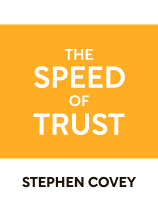

This article is an excerpt from the Shortform book guide to "The Speed of Trust" by Stephen M. R. Covey. Shortform has the world's best summaries and analyses of books you should be reading.
Like this article? Sign up for a free trial here .
Why is building self-trust important? What do experts say is the best way to build self-trust?
Stephen Covey, author of The Speed of Trust, says building self-trust is the first step in gaining trust from others. If you don’t trust yourself, then you could be engaging in certain behavior Covey says you should avoid.
Keep reading to learn how to build self-trust, according to Covey’s expert advice.
How to Trust Yourself
Covey explains that the benefits of trust begin within you and radiate outwards. He calls this effect the “waves of trust.”
If you want other people to trust you, you first need to build self-trust. According to Covey, self-trust is a function of harmony between your principles, your motives, your capabilities, and your track record. Essentially, self-trust comes from behaving in a way that reflects your values. Any dissonance between the person you want to be and your behavior can erode your self-trust.
For example, say you have a foundational belief that you are a kind person, but you find yourself berating your employees and being rude around the office. Since your behavior doesn’t reflect your values, you might start to question whether you are in fact, a kind person, and your self-confidence may be shaken.
To build self-trust, Covey suggests conducting an honest inventory of your nature and your proficiency. Once you know who you want to be and identify where your actions deviate from your personal mission and values, you can make a commitment to yourself to work on those areas. The more you keep these promises to yourself and the more alignment you see between your nature and proficiency, the more you will trust yourself.
| An Aligned Self-Concept Builds Self-Trust Covey’s discussion of harmony between our inner self (our principles and motives) and our outer self (our capabilities and track record) mirrors the idea of self-concept in the field of psychology. Some psychologists describe self-concept as having three parts: the ideal self (who we want to be), self-image (how we perceive ourselves right now), and self-esteem (how much we value ourselves). When there is alignment between the three parts of self-concept, we tend to feel good about ourselves (Covey explains it as trusting ourselves). But when there is dissonance between any of these three parts, we suffer emotionally and struggle to build self-trust. For example, if our ideal self is generous but our self-image is selfish, we might feel disappointed in ourselves and lose some of our self-esteem. Covey explains this difference between who we want to be and how we see ourselves behaving as a lack of congruence, which results in lower self-trust. |

———End of Preview———
Like what you just read? Read the rest of the world's best book summary and analysis of Stephen M. R. Covey's "The Speed of Trust" at Shortform .
Here's what you'll find in our full The Speed of Trust summary :
- Why trust is the ultimate key to success
- A roadmap for building and leveraging trust
- An explanation of Steven Covey's “four cores of credibility”






